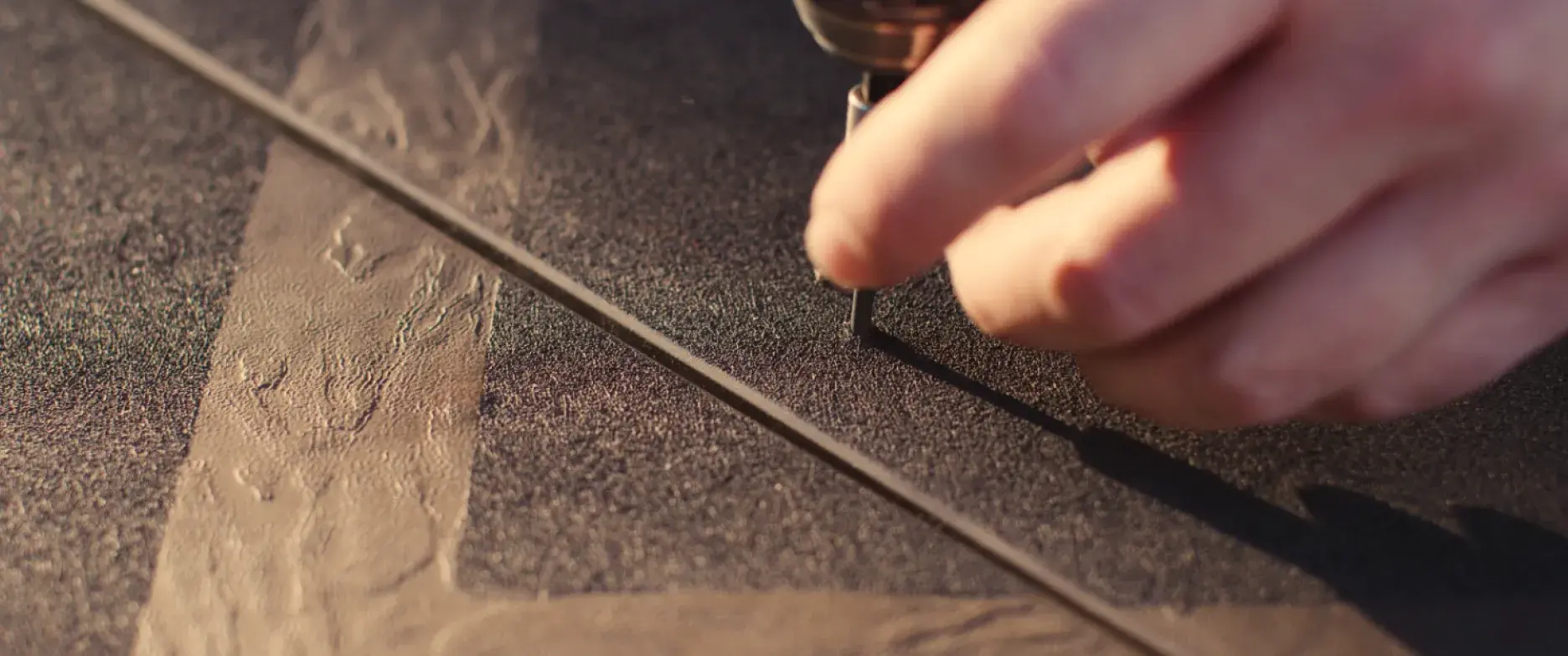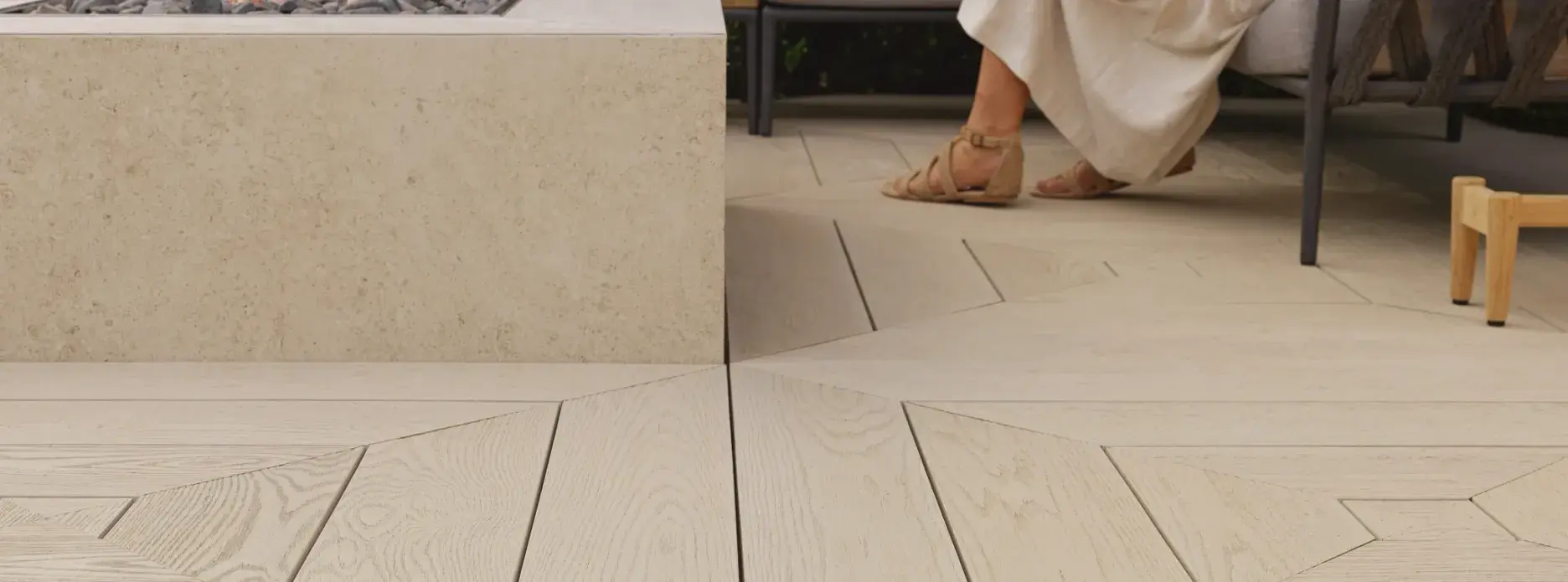MIllboard knowledgebase
The Benefits of Composite Decking vs Concrete Pavers

Article Highlights
When planning to enhance your outdoor living space, selecting the right patio materials is crucial. Two popular options - Composite decking and concrete pavers - both offer distinct advantages. This guide provides a balanced overview to assist homeowners, landscapers and designers in making an informed decision based on functionality, aesthetics, and maintenance considerations.
What is Composite Decking? Features and Benefits
Composite decking has emerged as a modern alternative to traditional timber decking for outdoor spaces. It offers long-lasting beauty without the drawbacks of natural wood with enhanced durability and requires little maintenance. Generic Wood Plastic Composite materials often use recycled plastic and wood fibres. However, Millboard decking is made from strong materials, including minerals, resin and recycled biopolymers. This high-performance composite decking is designed to withstand harsh weather conditions and resist common issues such as rot, warping, and algae growth. These can create unnecessary safety hazards in your outdoor living space.
Explore Millboard’s artisan hand-finished decking boards.
Explore the advantages of premium composite decking:
- Low Maintenance Needs: Requires only occasional rinsing with soapy water, eliminating the need for annual staining or sealing.
- Ease of Installation: Composite decking can be easily sawn and screwed using standard carpentry equipment. Millboard's innovative lost-head fixings make for a seamless installation process and clean finish.
- Durability: Highly resistant to weather elements, moisture, insect damage, and fading from direct sunlight exposure.
- Safety: The textured protective layer provides high slip resistance, even in wet conditions, for peace of mind about heavy foot traffic.
- Aesthetic Appeal: Available in a variety of colours, with intricate patterns, and different textures to complement diverse exterior design styles.
- Recycled Content & Conscious Practices: Some composite decking materials incorporate recycled water bottles or shopping bags. Meanwhile, some brands prioritise sustainable manufacturing practices.
Exploring Concrete Pavers for Outdoor Spaces
Concrete pavers are a traditional option for paved outdoor areas as they last a long time and come in a range of colours, shapes, sizes, and finishes, allowing for expansive design possibilities. Concrete pavers are known for their strength and versatility, making them suitable for patios, driveways, garden paths, and pavements. However, they ideally require level ground and a solid base which can complicate the installation process, make the subframe more complex or limit the size of the area.
Key characteristics of concrete pavers include:
- Versatility: Suitable for various design styles, from rustic to contemporary.
- Durability: High-quality pavers can withstand heavy foot traffic and a range of adverse weather conditions.
- Maintenance: Some materials may require regular sealing and cleaning to maintain appearance but if you keep on top of this they will keep a good aesthetic appearance
- Installation: Professional installation is usually required for optimal results.
While concrete pavers can create elegant and timeless outdoor spaces, they may demand more upkeep compared to composite decking.

Maintenance Considerations
Composite decking stands out for the minimal upkeep requirements. Its non-porous surface is highly resistant to stains and does not require sealing or painting. Regular cleaning with mild soap and water is typically sufficient to maintain the appeal of your new deck.
In contrast, a concrete patio, depending on the material, may need periodic sealing to prevent moisture absorption, staining in order to keep a nice appearance. They can also be susceptible to moss, lichen and algae growth, necessitating more frequent cleaning.
For homeowners seeking a low-maintenance solution, composite decking is generally the more convenient option.
Choose your favourite styles – order up to three free samples
Cost Analysis Over Time
The initial cost of composite decking can be higher than some concrete paver options. However, when considering long-term expenses, composite decking often proves more cost-effective due to its durability and low maintenance needs.
Concrete pavers and patio tiles vary in price based on material, with natural stone, porcelain patio tiles and high-end finishes being more expensive. Additionally, the installation process of concrete pavers can be labour-intensive, potentially increasing overall costs per square metre.
Property Value: Which Has Better Return on Investment?
Both composite decking boards and concrete pavers can enhance your outdoor living experience and therefore can contribute positively to resale value.
With its diverse appeal, low-maintenance nature, and durability, composite decking often commands a higher return on investment compared to concrete paving. Potential buyers are increasingly recognising the value of a well-designed outdoor decking area.
Make your house stand out – Explore Composite Decking options
Comparative Analysis: Composite Decking vs Concrete Pavers
Choosing between a concrete patio and Millboard decking depends on your project's needs, budget and personal preferences. Concrete is a budget-friendly and strong option. Meanwhile, composite decking is a stylish choice that is easy to take care of and looks elegant for decades.
Concrete patios are simpler to manage than traditional wooden decking. However, they might need regular cleaning. Resin-mineral decking doesn’t require staining, sanding, sealing or painting. This makes it a top pick for people wanting an easy outdoor space that looks stunning for years to come.
|
Feature |
Composite Decking |
Concrete Pavers |
|
Ease of Installation |
Lightweight, simpler installation process |
Heavier, often requires a solid base and level ground |
|
Maintenance |
Low maintenance, with occasional cleaning |
Moderate; may need sealing or staining |
|
Durability |
Resistant to cracking, rotting and insects |
Durable; varies by material |
|
Slip Resistance |
High, even when wet |
Varies; some surfaces can be slippery |
|
Aesthetic Options |
Wood-like finishes and intricate patterns available |
Wide range of colours and textures |
What are the Design Options for Concrete Patios and Composite Decking?
Composite decking is superb because it enhances the appeal and functionality of outdoor living areas. Millboard can offer the beauty of a natural wood decking without issues like warping, cracking or rotting.
Homeowners have many options for colours, styles and finishes, allowing them to design their outdoor space just how they like it. Whether you want a clean, modern look or a cosy, traditional feel, reinforced resin mineral decking can meet your needs and style preferences.
Explore wood effect Enhanced Grain decking in ten beautiful colours






Or select from three tones of Weathered Oak Decking, moulded from real antique oak boards



A beautiful deck is the perfect way to create more usable space on your property, and they’re also great at helping create the perfect atmosphere for entertaining, relaxing and encouraging outdoor living.
Concrete pavers are available in a range of shapes, patterns, and textures, making them a popular choice for outdoor spaces. However, their colour options may be more limited compared to resin-mineral composite decking, which offer a variety of pre-finished shades.
Our new Modello decking can be configured into over 50 different patterns, so your deck is as unique as your style.
Configuration Options
Composite decking gives you the most versatile design options for your outdoor living space. You can choose from different colours, styles and patterns to match the design of your home. Millboard’s flexible edging also makes it simple to create curved decking.
Choose between Enhanced Grain, Weathered Oak Modello or Lasta Grip. There is a wide range of colours, patterns and finishes available. You can also customise your decking further by choosing a herringbone or tessellating board pattern, offsetting boards or alternating board widths. Alternating board widths with Enhanced Grain is a fantastic way to achieve a more natural look.
While concrete patios can be sleek and simple,they require a more complex sub base for laying on steep slopes or uneven surfaces. Moreover, finding the right-shaped pavers for a curved patio can be more challenging.
Overall, resin-mineral decking is generally more appealing for most people and more versatile than a concrete patio. Deciding between the two will depend on your personal preference, budget and desired configuration. Millboard-approved installers can install an elevated deck which tailors to sloped gardens and uneven ground.
Start a project – use our handy decking configurator tool

Frequently Asked Questions
Is composite decking slippery when wet?
High-quality composite decking is designed with textured surfaces to enhance slip resistance, even in wet conditions. We have a collection specifically designed for enhanced grip, discover the benefits of Lasta Grip today.
Do concrete pavers require sealing?
Some concrete pavers, particularly those with porous surfaces, may require sealing to protect against moisture and staining.
Can composite decking be installed over existing surfaces?
Yes, composite decking can sometimes be installed over existing patios or concrete bases, provided the underlying surface is stable and properly prepared.
How do composite decks compare to concrete pavers with installation time?
Composite decking usually takes less time to install than concrete pavers. The time it takes can vary based on how complicated the project is. The relatively lightweight boards can be easily moved around and screwed in place, whereas concrete slabs are heavy and bulky.
How long does composite decking last compared to concrete pavers?
Both materials are durable. With proper maintenance, they can last a long time. Residential Composite decking can last over 20 years with minimal maintenance. Meanwhile, even with regular cleaning, concrete can start to discolour after just a few months when algae and lichen grow. Concrete pavers will remain structurally sound for decades but may lose their aesthetic appeal much earlier.
What do you need to consider before laying composite decking on concrete?
A concrete base is ideal for installing composite decking using our self-levelling pedestals. However, if you’re laying decking over an existing concrete patio, there are certain requirements. It must be secure, with no loose or skewed pavers, no cracks, gaps or damage. There also must be proper drainage for water runoff.





